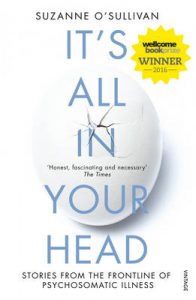Suzanne O’Sullivan is neurologist who has a particular interest in epilepsy. As a result she encounters people who have ‘dissociative seizures’ – fits which are not accompanied by the usual abnormal brain wave activity. These ‘pseudo’ seizures – the term has now been superceded – form the entry point for the world of ‘psychosomatic’ illness and ‘psychogenic’ conditions.
Anyone who works as a clinician will meet people who have symptoms that are unexplained by their diagnosis, or not consonant with neuroanatomy, or whose severity seems out of proportion with the pathology causing them. Indeed, anyone working as a clinician for any length of time will be aware of how symptoms are affected by emotions, mood, and social experiences. It’s All In Your Head (2015) explores the world of ‘psychogenic’ conditions, through a series of vivid case studies, that amply illustrate the complexity of this very common phenomenon.
The book starts with a discussion of blushing and tears, and analyses the integral role of emotions in our sensing and functioning of our bodies, before examining the way in which changes in our brains can have profound effects on our bodies’ functions. The people in these case studies demonstrate a wide range of symptoms, ranging through dissociative seizures, blindness, pain, chronic fatigue, and partial paralysis, all resulting from changes in the brain rather than in easily diagnosable pathologies.
O’Sullivan convincingly describes the careful process of diagnosis by exclusion, and even more convincingly the tendency to deny responsibility to treat by clinical specialists who shunt people with distressing symptoms to other specialists – a phenomenon that only serves to accentuate each person’s need for someone to hear and validate their distress. The strong social stigma about symptoms deriving from psychological upsets and stresses affects both the ‘patients’ and carers who are given such an explanation, and the clinicians who make them.
‘Mind-body’, ‘body-mind’: how difficult it is to avoid this type of language! It’s All In Your Head on the one hand proclaims the inadequacy of the Western and Cartesian dualism that divides ‘body’ from ‘mind’. On the other hand it demonstrates how hard it is, both here, and when talking to patients and their families, to avoid resorting to the equation ‘mind affects the body, just as body affects the mind’. Such causal connections can aid understanding but at the same time preserve the unhelpful concepts we are trying to leave behind. Neuroscience today might portray ‘mind’ as the product of the body (including the brain), such that body and brain are all one entity (for example in the accounts by Damasio and others on the subconscious role of emotion and sensory experience in decision-making). The poverty of Western concepts of ‘mind’ and ‘body’, and yet their on-going potency in our thought, are apparent in this exploration of the ‘psychosomatic’.
The author is sympathetic to her patients, and very clear that ‘ruling out disease is not the same as ruling out illness.’ She listens very carefully to her patients’ stories and accounts of their symptoms, hearing and validating their distress. She gives an honest account of how clinical experience has given her an open-mindedness towards people with these symptoms that she did not have as a medical student or earlier in her career – and this rings very true. Conscious faking of symptoms is apparently very uncommon (although it happens): rather, most cases of ‘somatic disorders’ are unconscious manifestations of distress, combined with socially conditioned illness behaviour. Apparently the scans of people having dissociative seizures differ not only from normal brains but also from those of people deliberately faking such symptoms. The neurophysiotherapist will undoubtedly encounter people whose bodily symptoms are affected by their emotional/mental state more than by any ‘physical’ pathology, and so needs to have the same open-mindedness and empathy that is displayed here. Societal attitudes and the social stigma attached to ‘psychological illness’ often create a vicious circle that increases a person’s distress and symptoms. Physical therapists can be an unwitting engine in this vicious circle. All physiotherapists need to read this book.
O’Sullivan, Suzanne (2016) It’s All In Your Head, London, Chatto & Windus
